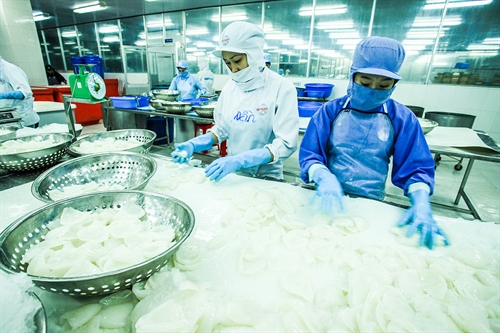 Economy
Economy

Executives from 10 companies in Korea’s Hamyang County yesterday met with 50 Vietnamese counterparts in HCM City to exchange information and explore business opportunities.
 |
| Workers process food for export to Japan and the RoK at Ngô Quyền Processing Export JSC in Kiên Giang Province. In the first three months of this year, the RoK sold commodities worth US$7 billion to Việt Nam. - VNA/VNS Photo Trọng Đạt |
HCM CITY – Executives from 10 companies in Korea’s Hamyang County yesterday met with 50 Vietnamese counterparts in HCM City to exchange information and explore business opportunities.
The visitors specialise in supplying agriculture-based products like apple, pear, onion, strawberry, king oyster mushroom, bitter melon tea, Korean traditional black raspberry wine, wild ginseng drink, purple sweet potato drinkables, walnut-shaped songpyeon, white lotus naengmyeon, lotus leaf tea, and others.
Im Changho, mayor of Hamyang, said through the meeting his county sought to promote its quality agricultural products and wild ginseng.
Hoàng Văn Anh of the Việt Nam Chamber of Commerce and Industry said trade with Korea has grown rapidly and it is now one of Việt Nam’s largest trade partners.
Korea is also among the largest foreign investors in the country, having more than 4,000 companies that employ more than 700,000 people, he said.
The Việt Nam-Korea Free Trade Agreement that took effect last December is expected to open up businesses opportunities in the two countries, he said.
In addition to business co-operation, Korean firms with their technological prowess could help Vietnamese firms develop agricultural products and export markets, he said.
Hamyang and CEOLink Corporation, a pioneer in Việt Nam in offering online and offline B2B business models, signed an agreement to promote the county’s products in Việt Nam.
RoK’s exports to Việt Nam
The Republic of Korea (RoK) exported more to Việt Nam in the first quarter of 2016 compared to the same period last year, while its exports to other nations, particularly China, dropped significantly, reported the Korea International Trade Association (KITA).
In the first three months, the RoK sold commodities worth US$7 billion to Việt Nam – its third biggest importer – representing a 7.6 per cent annual increase. By contrast, revenue of the country’s shipments to its number one importer China fell by 15.7 per cent annually to $28.5 billion, the biggest drop in the past seven years.
Regarding the types of products imported to China, the number of conductors, flat screens, petrochemical products, auto spare parts and synthetic materials plunged during the given period. Park Jin-woo, head of KITA’s market research office, said China had invested heavily in expanding local conductor manufacturing to reduce imports.
He advised Korean firms to exploit the potential of the household-article market.
Also in the first quater, the RoK’s export value to the US and Japan decreased by 3.3 and 13.1 per cent to $16.8 billion and $5.5 billion, respectively. -- VNS




